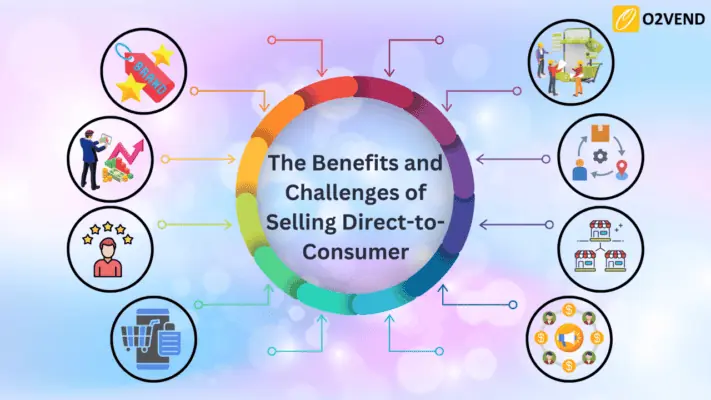
Direct-to-consumer is that it allows retailer businesses to have full control over their brand message and customer experience. By bypassing intermediaries such as wholesalers or retailers, businesses can directly communicate with their customers and ensure a consistent and personalized experience. The campaign direct to consumer also allows businesses to gather valuable customer data and insights. With direct access to customer feedback and preferences, companies can tailor their products and marketing strategies to meet specific customer needs. Additionally, direct-to-consumer provides businesses with the opportunity to build direct relationships with their customers to selling their products directly with physical store. This direct connection enables businesses to establish trust and loyalty, leading to increased customer retention and repeat purchases. By selling products directly to customers with online shopping, businesses can also have better control over pricing and profit margins, as they eliminate the costs associated with middlemen. Overall, the profit of selling their products to consumer empowers businesses to streamline their operations, enhance customer satisfaction, and maximize their profits to the end customer.
1. Introduce about Example Direct-to-consumer Selling ( dtc )
In today’s ever-evolving business landscape, companies are continually seeking innovative ways to connect with their target customers and deliver products effectively about dtc sales. One approach that has gained significant traction is Direct-to-Consumer (D2C). By cutting out intermediaries and directly to the consumer business, brands can reap a multitude that go beyond traditional retail channels. In this article, we will delve into the advantages of adopting a D2C and explore how businesses can overcome the associated challenges to leverage its full potential about you’re selling direct.
2. What are the benefits of direct to consumer dtc Brand?
The selling d2c model offers several profits to businesses with sales strategy and buy directly. By bypassing traditional sales channels, companies can make a deal to consumers to selling to your customer, eliminating the need for intermediaries and reducing costs for online sales. This enables businesses to optimize their pricing and provide customers with fairer prices with the key benefits of dtc selling. Additionally, selling direct to customers business to gather valuable customer data. This data can be used to understand consumer behavior and preferences, leading to more personalized marketing efforts and improved customer experiences. Moreover, the DTC model provides businesses with greater control over the customer experience throughout the entire customer journey to the end consumer communicate directly. From pre-purchase to post-purchase interactions, businesses can shape the customers directly to align with their brand values and unique proposition to reap the benefits. This control over the customer and access to customer data also contribute to building brand loyalty consumers prefer to buy directly. By establishing direct relationships with customers to sell your products, businesses can cultivate trust, foster brand advocacy, and encourage repeat purchases.
3. Understanding Manufacturer Advantage Direct-to-Consumer Sales

Before we dive into dtc strategy, it’s essential to grasp the concept fully. Selling directly to the consumer refers to the practice where manufacturers or brands directly their products, bypassing traditional retail partners or middlemen to range of benefits from sell directly to customers. This model allows companies to take complete control of their sales and distribution channels, leading to enhanced customer engagement and improved profitability.
4. Benefits to Brands of Selling Directly to Consumers

- Greater Control and Flexibility
Unlike traditional retail, where brands rely on third-party retailers to represent their products, D2C selling empowers businesses to have full control over their brand image, messaging, and pricing. With the ability to make real-time adjustments, companies can respond rapidly to market trends and preferences with direct-to-consumer business model. This level of agility ensures that brands stay relevant and maintain a competitive edge.
- Closer Customer Relationships
One of the most significant of D2C selling is the opportunity to establish direct connections with customers. By engaging directly with consumers packaged goods also advantages of selling and reap the profits of selling, brands can gain valuable insights into their preferences, pain points, and expectations about marketing and selling to consumers rather than selling to customers. This valuable data fosters personalized interactions, leading to stronger customer and increased loyalty.
- Improved Data Collection and Analysis
In the D2C model, brands have access to a wealth of first-hand customer data, build ongoing relationships with consumers, enabling them to make data-driven decisions way for consumers to go to choosing the good product. Through website analytics, social media interactions, and purchase behavior, businesses can understand their customers better and refine their marketing accordingly. The wealth of data also facilitates accurate forecasting, inventory management, and targeted marketing campaigns.
- Increased Profit Margins
By eliminating the need for intermediaries, brands can retain a more significant portion of their profits also directly from the brand. Traditional retail often involves wholesale discounts and fees to distributors, resulting in lower profit margins for manufacturers. In contrast, D2C selling allows businesses to offer competitive prices while maintaining healthier profit margins.
- Brand Building and Customer Loyalty
D2C selling enables brands to convey their unique stories and values. By crafting compelling narratives and authentic brand experiences, companies can differentiate themselves in the market and build a tribe of loyal customers buy direct and selling. This sense of loyalty leads to repeat purchases and word-of-mouth marketing, further fueling the brand’s growth.
5. Challenges of Manufacturers Selling Directly to Consumer of Retailer
While the D2C selling are enticing, there are also some challenges that businesses may encounter along the way. Let’s explore how to overcome these hurdles and make the most of the D2C model for direct sales.
- Efficient Supply Chain Management
With direct selling, brands take on the responsibility of managing the entire supply chain, from production to delivery. To ensure smooth operations, companies must adopt efficient supply chain management practices, including inventory optimization, demand forecasting, and logistics coordination.
- Embracing Digital Marketing
In the digital age, marketing plays a crucial role in D2C success. Brands need to embrace digital marketing such as search engine optimization (SEO), content marketing, social media advertising, and influencer collaborations to reach their target audience effectively and lead to more sales direct connection with their customers.
- Enhancing Customer Experience
In a D2C model, the customer is linked to brand perception and loyalty. Businesses must focus on providing seamless and delightful customer, from a user-friendly website to prompt customer support. Investing in customer can yield long-term dividends in the form of loyal customers and positive word-of-mouth.
6. Leveraging Social Media for Selling Direct-to-consumer Success
Social media platforms have become instrumental in modern marketing strategies, especially for D2C brands. Let’s explore how different platforms can be leveraged for success.
Instagram: Visual Storytelling for Brands
Instagram’s visual-centric nature makes it an ideal platform for brands to showcase their products creatively. By sharing captivating visuals and engaging stories, brands can connect with their audience on a deeper level and spark interest in their offerings.
TikTok: Engaging the Younger Audience
For brands targeting a younger demographic, TikTok offers immense potential. By creating entertaining and relatable content, companies can capture the attention of Gen Z and Millennials, fostering brand awareness and loyalty among this tech-savvy generation.
YouTube: Creating Authentic Connections
YouTube provides a unique opportunity for brands to create authentic and informative video content. By sharing product reviews, tutorials, and behind-the-scenes footage, companies can establish themselves as trusted authorities in their niche.
7. Embracing Innovation for Direct-to-consumer Brand Growth
To thrive in the D2C landscape, businesses must continuously innovate and adapt to changing consumer preferences. Let’s explore two innovative strategies that can fuel D2C growth.
Subscription Models: Fostering Customer
Subscription models offer a win-win situation for both brands and consumers. For brands, recurring revenue and improved customer retention are major advantages, while consumers from the convenience of receiving products regularly.
Voice Commerce: Facilitating Convenience
With the rise of voice-activated devices like smart speakers, voice commerce presents an exciting opportunity for D2C brands. By enabling customers to make purchases through voice commands, brands can provide a seamless and convenient shopping experience.
8. Conclusion about Examples of Manufacturers Selling Directly with Business Model
Selling dtc means has emerged as a game-changer in the world of modern commerce. By embracing this model, businesses can enjoy greater control over their brand, foster closer customer relationships, leverage data-driven insights, and boost profit margins and understand the profit. While challenges exist, overcoming them with efficient supply chain management, digital marketing prowess, and a focus on customer can lead to unparalleled success, beside you need to looking for a private agent to help you sourcing products from factory in China and fulfillment. By harnessing the power of social media and embracing innovative strategies, brands can take their D2C growth to new heights, ensuring a thriving and prosperous future.
9. FAQs for Challenges of Selling and Going Direct to Consumer
-
What is Direct-to-Consumer (D2C) selling? D2C selling refers to the practice where manufacturers or brands sell their products to consumers, bypassing traditional retail partners or middlemen.
-
What are D2C selling? D2C selling offers advantages such as greater control and flexibility, closer customer relationships, improved data collection and analysis, increased profit margins, and brand building and customer .
-
What challenges do businesses face in D2C selling? Some challenges include efficient supply chain management, embracing digital marketing strategies, and enhancing customer experience.
-
How can brands leverage social media for D2C success? Brands can utilize platforms like Instagram for visual storytelling, TikTok for engaging the younger audience, and YouTube for creating authentic connections.
-
What innovative strategies can foster D2C growth? Subscription models can foster customer, while voice commerce can facilitate convenience and seamless shopping experiences.
Private Agent for Dropshipping Success